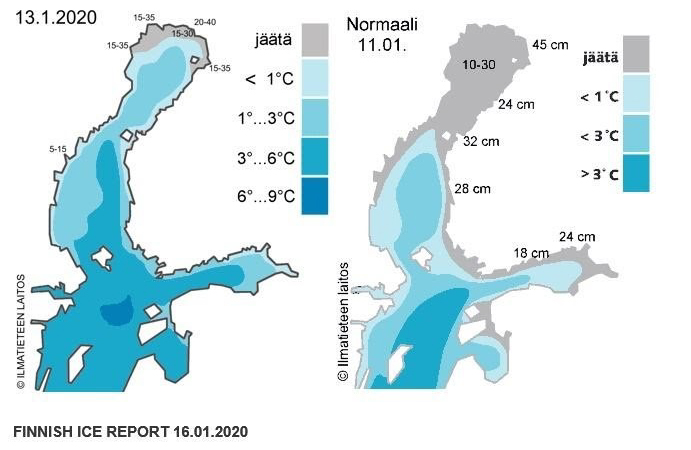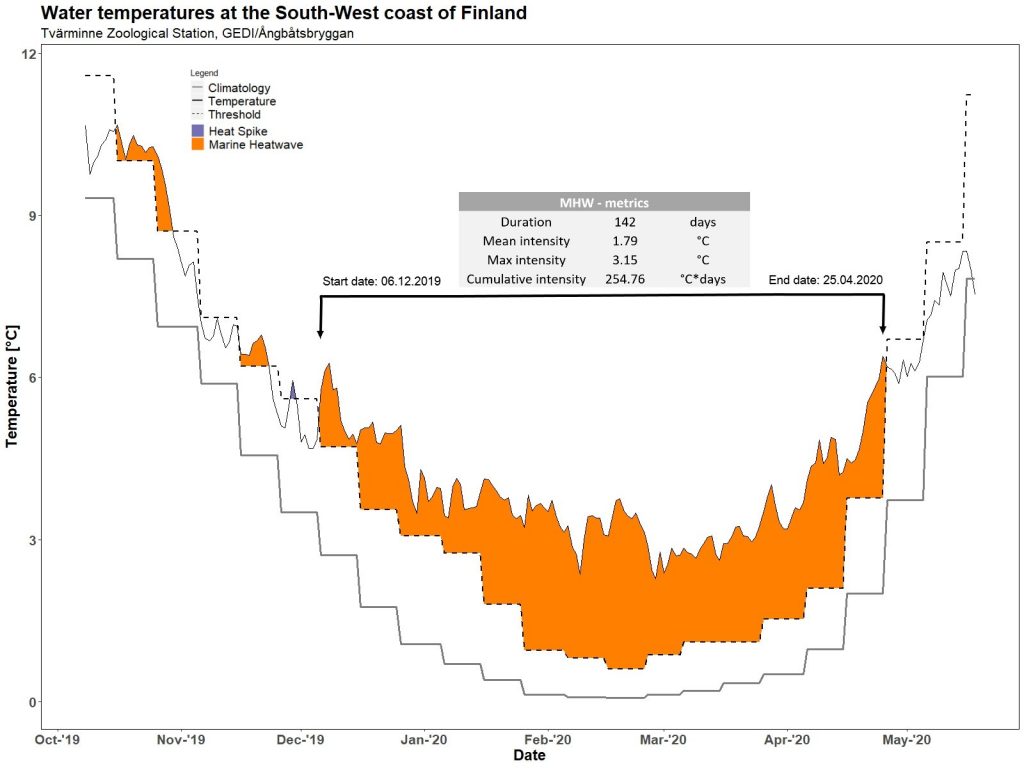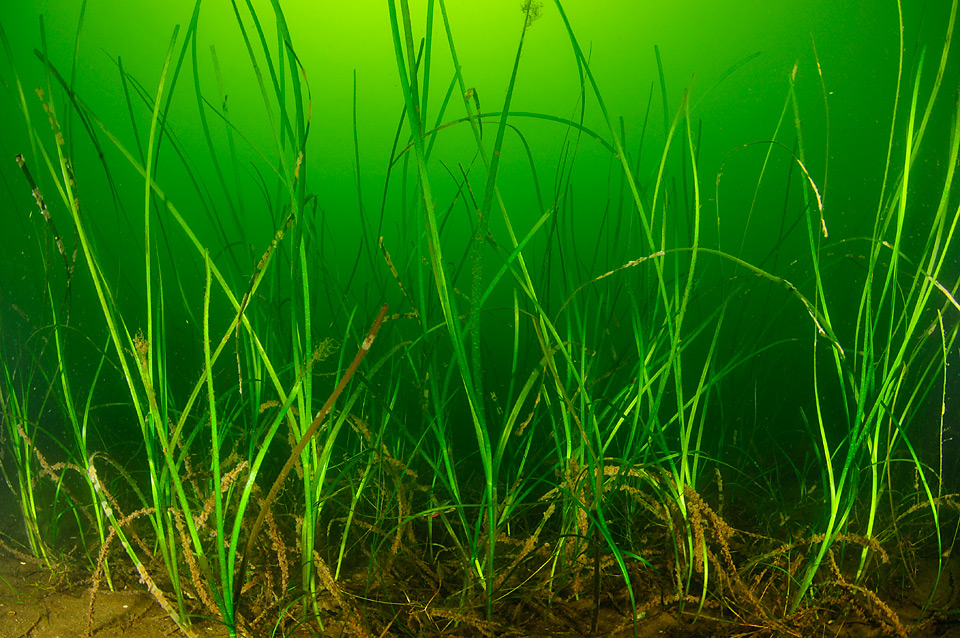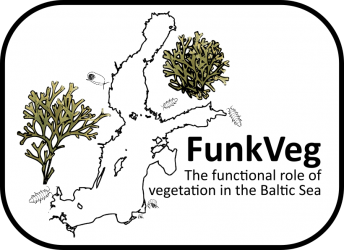The ice is disappearing… Over this winter there was no walking on the sea around Helsinki, or in much of Finland for that matter.
In January the ice cover was dramatically lower than normal for the Baltic Sea. Normally the ice should extend from the northern parts of the Baltic down to the Gulf of Finland and the Gulf of Riga, however this year the ice was limited to just a small section of the Bothnian Bay.
Indeed this lack of ice is a tell-tale sign of a milder winter, both on land and in the sea.

But was last winter an odd exception?
It appears not. The earth is experiencing a warming of the marine environment in general, but the Baltic Sea is warming far more severely than the average global ocean. The Baltic Sea temperature is now higher than that average temperature recorded between 1981-2010 (European Environmental Agency, 2019)

However it is not solely the increase in temperature that is concerning for the marine environment. Shorter spells of prolonged warmer temperatures, called marine heatwaves, are also troubling.
Due to climate change the IPCC (2013) expects marine heatwaves to become more frequent, and those that we do experience to be far more intense. Already the marine environment has experienced a 54% increase in annual marine heatwave days (Oliver et al., 2018).
And Finland is no exception. Monitoring at the University of Helsinki’s Tvärminne Zoological Station points that last winter was just one long marine heatwave. Exceptionally warm conditions lasted an outstanding 142 days, and even included record breaking temperatures in February 2020 (@Tvärminne, 2020).

Are marine heatwaves really all that bad?
Prolonged high temperatures can induce heat stress in marine plants and seaweeds with disruptive consequences to the survival of these organisms.
This stress can reduce a marine plant or algae’s ability to persist within previously inhabited areas. Consequently heatwaves have the potential to cause local extinctions.
By 2200 three currently common seaweeds; bladder, serrated and knotted wrack; will have disappeared from any North-Atlantic shore south of 45 ° latitude due to marine heatwaves and the other effects of climate change (Jueterbock et al., 2013).

Serrated wrack, Urter island, Karmøy, Norway (Image source ©OCEANA)
How will marine heatwaves affect Baltic Sea ecosystems?
Recent research at GEOMAR Helmholtz Centre for Ocean Research sheds some light on this.
By using large, outdoor tanks called ‘mesocosms’, researchers tested how eelgrass and bladderwrack respond to heatwaves (Saha et al., 2019). Within these 1,500l tanks the eelgrass and bladderwrack were subjected to 9 day heatwaves.

Eelgrass meadow, Puck Bay, Poland (Image source ©OCEANA)
So how did the plant and seaweed cope?
Well is seems that both eelgrass and bladderwrack are fairly resilient to heatwaves. The eelgrass did experience impaired growth, but also showed good signs for potential recovery. Bladderwrack, on the other hand, showed no impaired growth with the only significant effect being seen on the bacterial community living on the algae.
Therefore it seems that both eelgrass and bladderwrack will likely be able to endure short heatwaves similar to those of this experiment when experienced within the natural environment.

Wrack, Västra Banken, Bothnian Sea, Sweden (Image source ©OCEANA)
However it is not all good news. The effects of long heatwaves will probably be fairly different. In a previous study subjecting eelgrass to a continuous 3 week heatwave far greater detrimental effects where observed (Winters et al., 2011).
So a tolerance to short heatwaves does not necessarily equate to a tolerance to longer ones. Consequently the length of each heatwave will be critical to determining the effects on eelgrass and bladderwrack.
We will have to endure more and hotter marine heatwaves, as will the resident plants and animals of the Baltic Sea, yet at least eelgrass and bladderwrack seem somewhat prepared for the future.
Sources:
@Tvärminne, 2020. Tvärminne Zoological Station. Date accessed: 28/5/20. https://www.facebook.com/Tvarminne/posts/2426296717472671
European Environmental Agency, 2019. Decadal average sea surface temperature anomaly in different European seas. Date accessed: 29/5/20. https://www.eea.europa.eu/legal/copyright
IPCC, 2013: Climate Change 2013: The Physical Science Basis. Contribution of Working Group I to the Fifth Assessment Report of the Intergovernmental Panel on Climate Change [Stocker, T.F., D. Qin, G.-K. Plattner, M. Tignor, S.K. Allen, J. Boschung, A. Nauels, Y. Xia, V. Bex and P.M. Midgley (eds.)]. Cambridge University Press, Cambridge, United Kingdom and New York, NY, USA, 1535 pp, doi:10.1017/CBO9781107415324.
Jueterbock, A., Tyberghein, L., Verbruggen, H., Coyer, J.A., Olsen, J.L. and Hoarau, G., 2013. Climate change impact on seaweed meadow distribution in the North Atlantic rocky intertidal. Ecology and evolution, 3(5), pp.1356-1373.
Saha, M., Barboza, F.R., Somerfield, P.J., Al‐Janabi, B., Beck, M., Brakel, J., Ito, M., Pansch, C., Nascimento‐Schulze, J.C., Jakobsson Thor, S. and Weinberger, F., 2020. Response of foundation macrophytes to near‐natural simulated marine heatwaves. Global Change Biology, 26(2), pp.417-430.
Winters, G., Nelle, P., Fricke, B., Rauch, G. and Reusch, T.B., 2011. Effects of a simulated heat wave on photophysiology and gene expression of high-and low-latitude populations of Zostera marina. Marine Ecology Progress Series, 435, pp.83-95.

